Blog documenting our progress trying to clear the VCU sidewalks (Run by Aiden)
Don't wanna be here? Send us removal request.
Text
Sprint 5 Overview
Sprint Recap:
For our fifth and final Sprint, our main goal was to focus on the distribution of our posters and messages to as many places as possible. Last Sprint, we were in the process of printing our posters and had submitted our posters to multiple VCU distribution services such as Cabell Library, VCU Social Media, etc.
The first thing accomplished during this Sprint was printing and distributing our posters around campus. Lillie, Alo, and Dalton split the printed posters amongst themselves and put them in places such as nearby bus stops and inside school buildings. Most of the posters were taken down immediately, but some stayed up until the end of the semester.
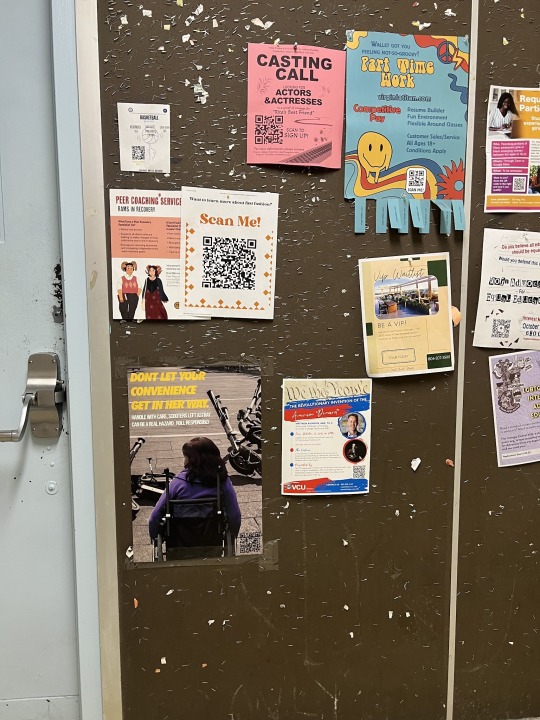
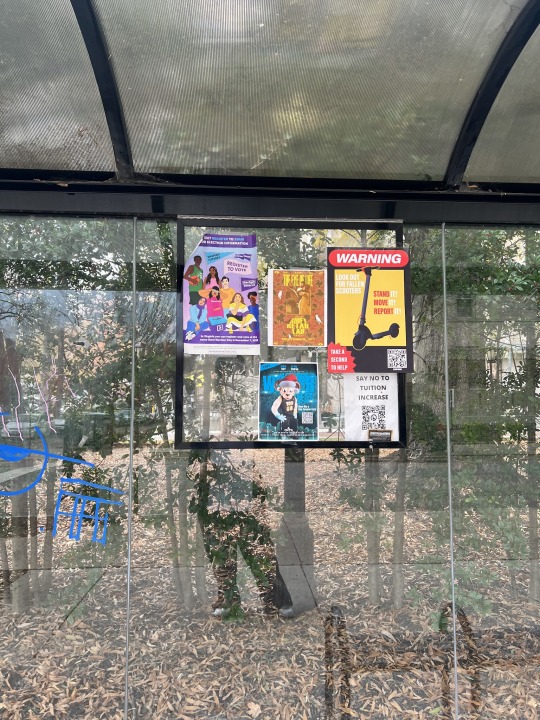
While the posters spread the word about picking up the e-scooters, they didn’t bring much engagement to our Link-tree. We decided to post our poster design along with our Link-tree link to the r/rva and r/vcu subreddits. We wanted to receive feedback about our poster designs to ensure they came across as we intended.
Both posts received lots of engagement almost immediately after we posted them. r/vcu ended up getting 33 upvotes and 22 comments. r/rva was even more successful receiving 67 upvotes and 104 comments. As expected from websites like Reddit, lots of the comments were either jokes or mean and unhelpful comments. The Redditors leaving helpful critiques all had similar things to say about our design. They all pointed out how our team's goal of making the sidewalks more accessible didn’t come across well in the poster. Redditors only knew about our goal to help those with mobility issues when I added an extra comment clarifying why we were doing this. Most assumed we were trying to do the scooter companies' jobs for them. They recommended we add some sort of blub or design on our poster indicating that this is to help the community rather than corporations.

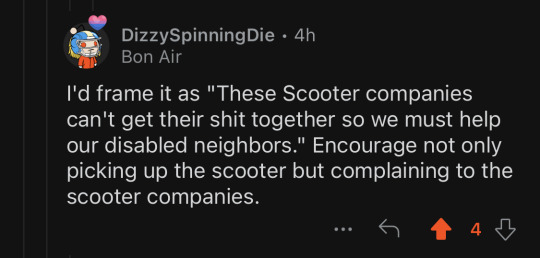
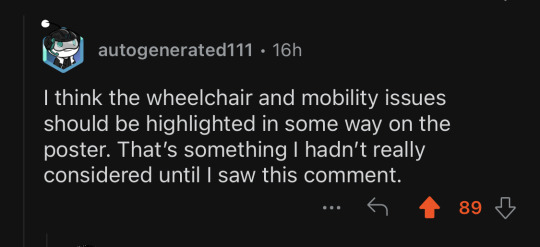
Thanks to this feedback, we also decided we would distribute Dalton’s old poster design that talked about mobility issues and scooters. This poster showed how fallen scooters can make it hard for wheelchair users to use the sidewalks safely.

Even if the reaction to our posters was mixed on Reddit, it still shot up our engagement on Link-Tree. We got a total of 29 views that day, 24 unique views, 25 total clicks, 13 unique clicks, and a click-through rate of 86.21%.
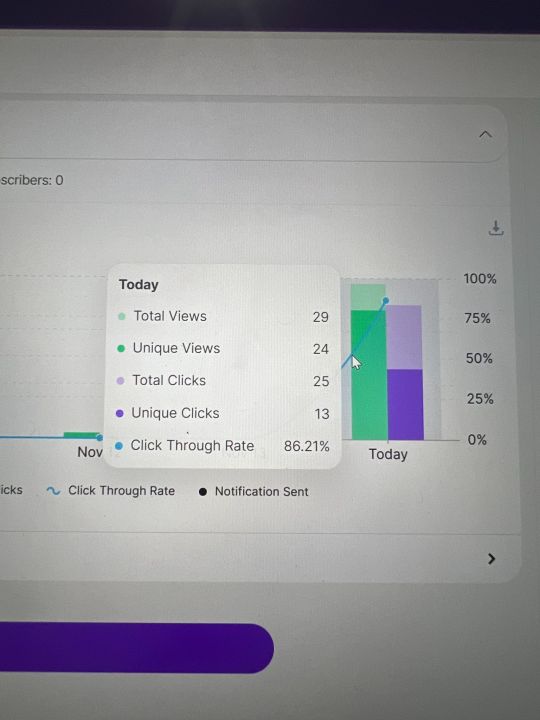
Along with our poster distribution and Reddit postings, we also submitted our designs to VCU distribution sites. We initially submitted our designs to VCU’s social media page, the Student Commons digital screens, the Commonwealth Times, the Cabell Library digital screen, the Stall Street Journal, and Telegram. We also messaged Byrd/Lime about putting our posters on their story and were even told by GRTC that they would put up posters on their bus stops and post us on their story.
The first ones to get back to us were the people in charge of the Student Commons digital screens. They sent us an email letting us know that our design was in their rotation of images and should play in the Commons. However, when I went to check, I noticed our design never came up. I sat for over half an hour while the screens kept repeating the same messages. I emailed the people in charge of the digital screen but they weren't able to help us fix the problem before the end of the semester.
VCU social media got back to us almost immediately and let us know that they would post our poster and Link-tree link every week on the official VCU Instagram story until the end of the semester. I’ve checked back every week and can confirm that our message plays weekly on their story.

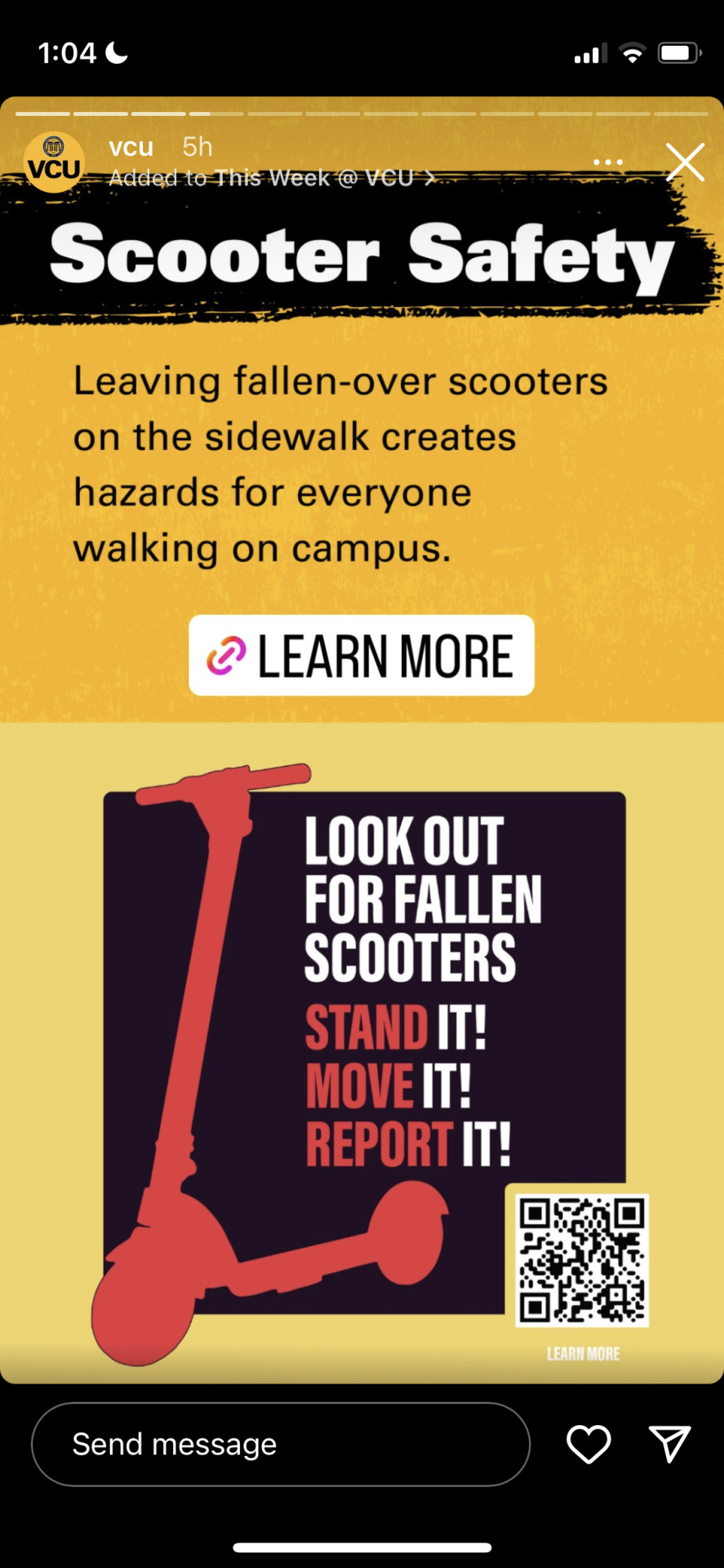
When we messaged the Commonwealth Times about putting our poster in their newspaper, they had already printed their last volume of the year. While we weren’t able to be posted in the physical release, they let us know that they would post us on their digital newsletter on December 1st. When December 1st came, they indeed posted us in the newsletter. We were the very first image when opening up the newsletter.

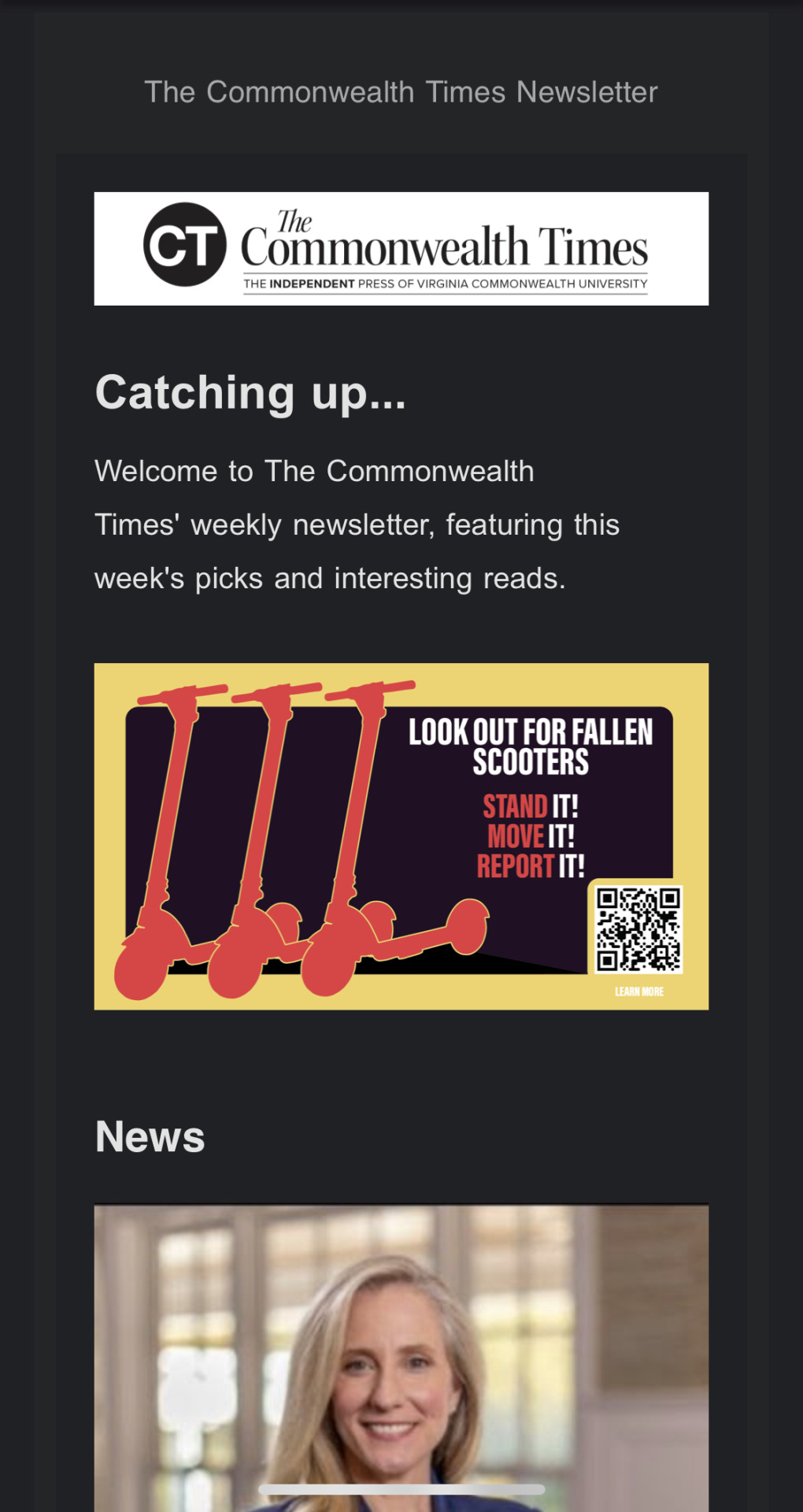
The Cabell Library digital screen, Telegram, and Byrd/Lime never responded to our requests. Stall Street Journal also didn’t put us in an issue but they are focused on mostly mental/physical health issues so it makes sense why scooter safety wouldn’t fit in with their usual articles. Even though I spoke with Henry from the GRTC’s marking team and he approved our ideas, he never responded to any of my follow-up emails so we couldn’t do anything officially with the GRTC.

Towards the beginning of Thanksgiving Break, I got an email from Susan Sutphin (MPC Campus Coordinator) that Corey Beyers (University Relations) and Molly Case (Communications) would love to meet with us after the break to help us distribute our poster designs.

Once break was over, we met up with everyone over Zoom. I let both Corey and Molly know about what we were doing for our project, what our goals were, and what we had accomplished so far. They both congratulated us on how much we had done already and were unsure how much more they could help us with. Since Corey has direct connections with VCU’s police, she told us she could create a “Geofenced Alert", which is when an alert pops up on your phone when you approach a specific area. She told me to give her 6 locations on campus where students would automatically receive a message telling them to pick up scooters if they stepped near those areas. This was all to be done through the Livesafe app which is a safety alerts app that VCU suggests all students download. She also said she would post us on all of the VCU police social media on December 4th. We agreed and she set up the Geofence to run December 4th-6th.
Molly told us there wasn't much more she could do for us since we submitted to almost all of the VCU distribution sites. She was the one who suggested we submit it on Telegram but when we did, we were denied.
On December 4th, VCU police posted us on their Instagram, Instagram stories, X (Twitter), Facebook, and Threads.
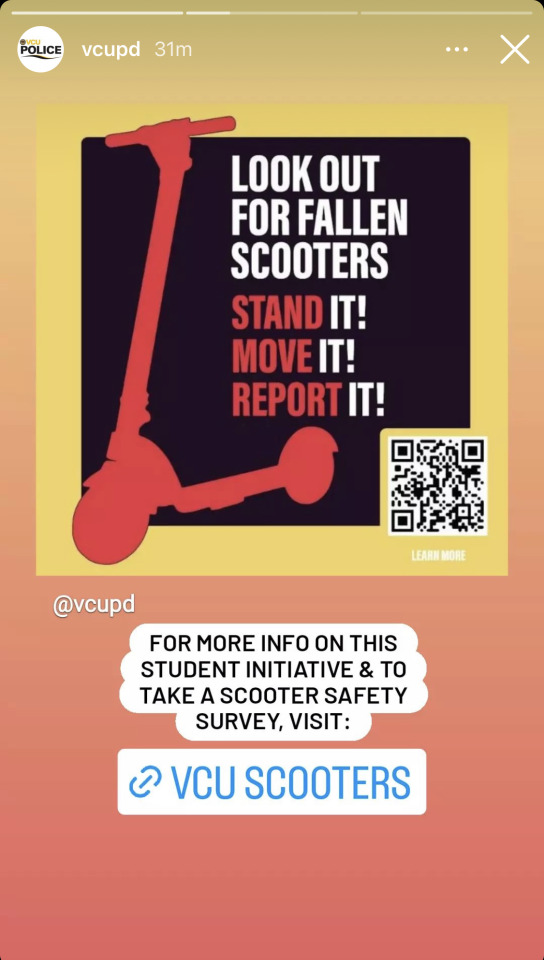
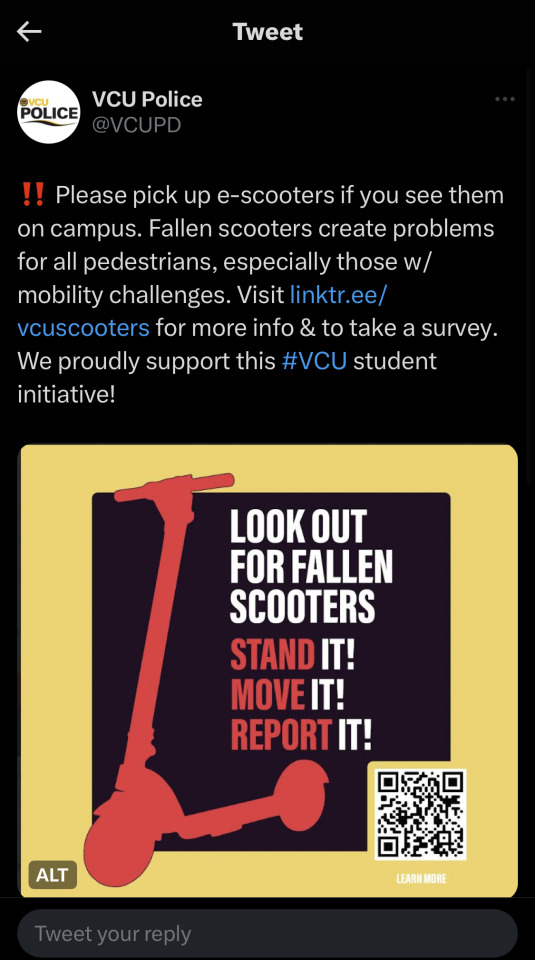
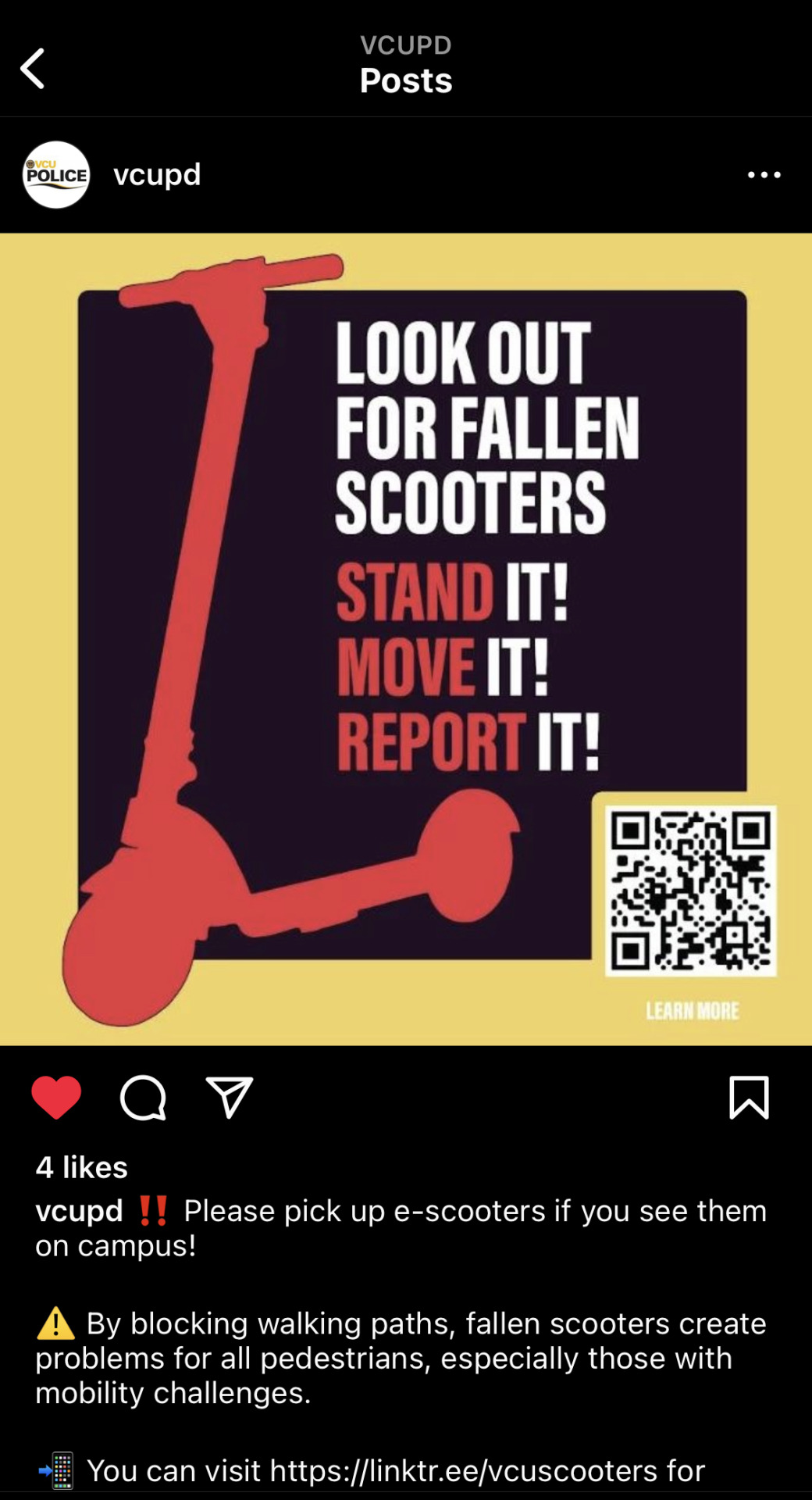
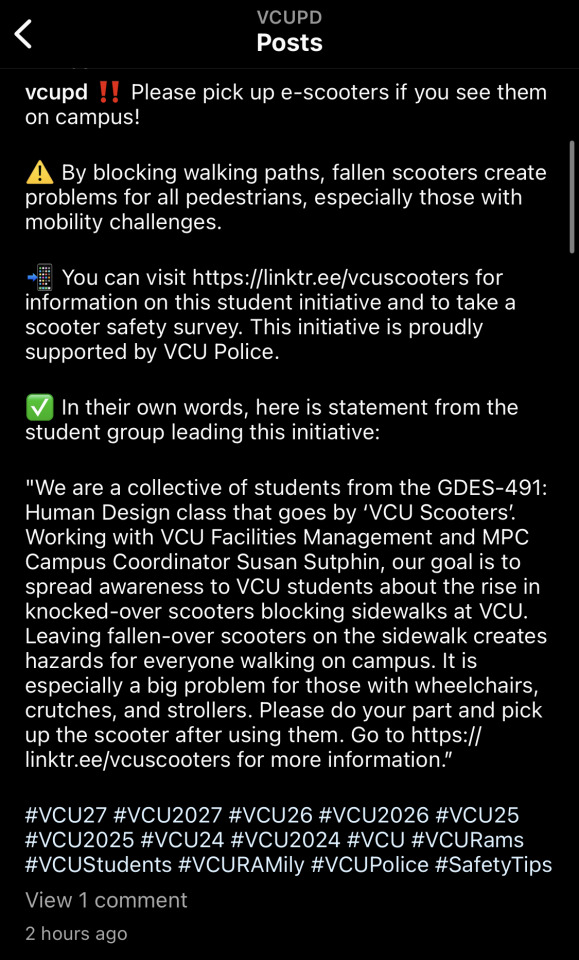

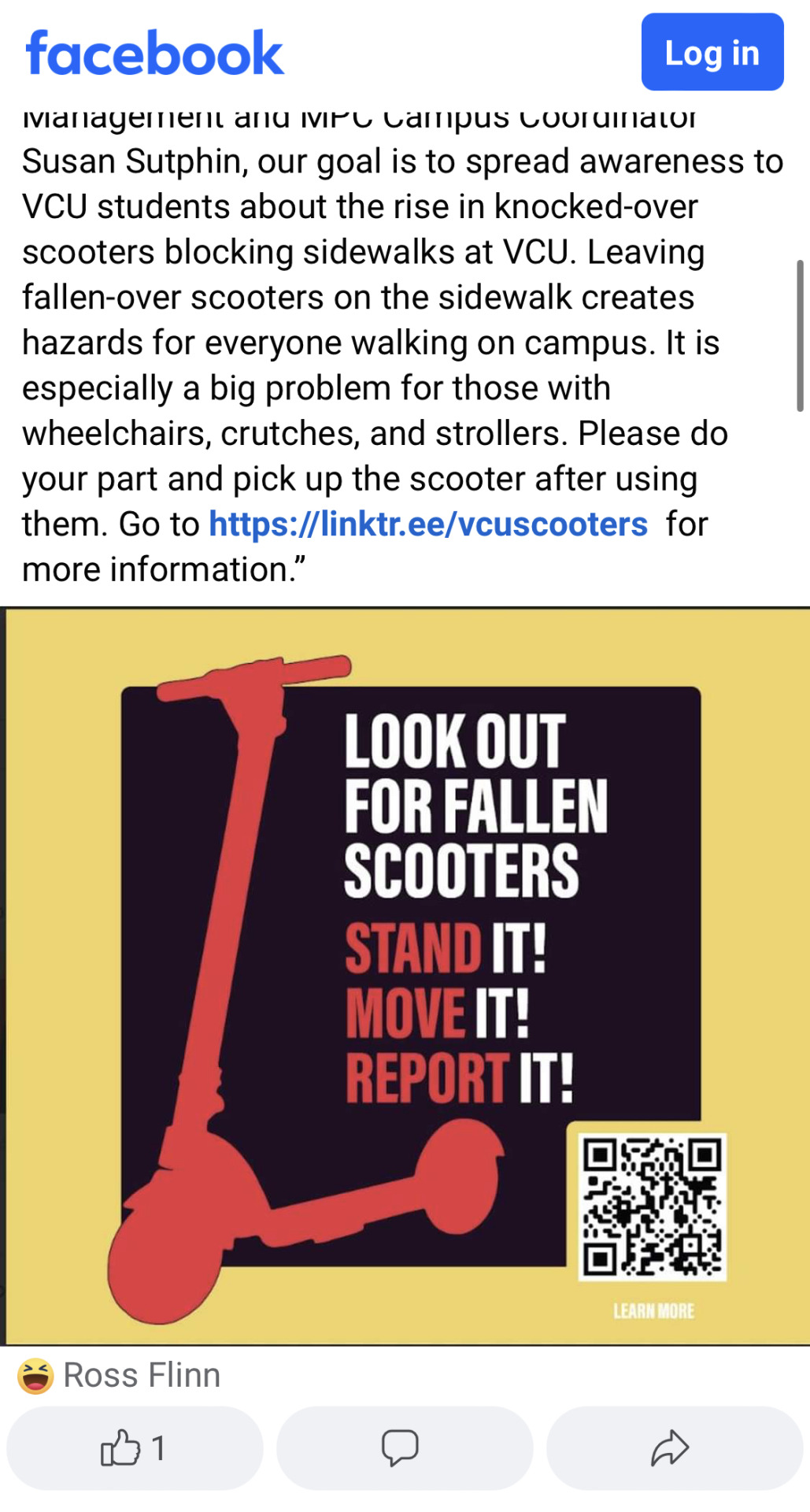
On Wednesday, December 6th, she shared with us all of the stats from the three days the posts were active. VCUpd’s Facebook reach and engagement reached 311, Instagram reach and engagement reached 508, Instagram stories reached 122 views, Twitter reach and engagement reached 188, and Threads reached 0. Corey informed us that the VCU police Threads account doesn’t ever get engagement since Threads isn’t as popular as other social media.

The Geofence alert ran for three days as well and was set up at Cabell Library, The Student Commons, Harrison Street Cafe/Village Cafe, Monroe Park, Cary Street Gym, and Bowe Street Deck. I walked in these areas to test this out and can confirm that I received the alert on the Livesafe app.
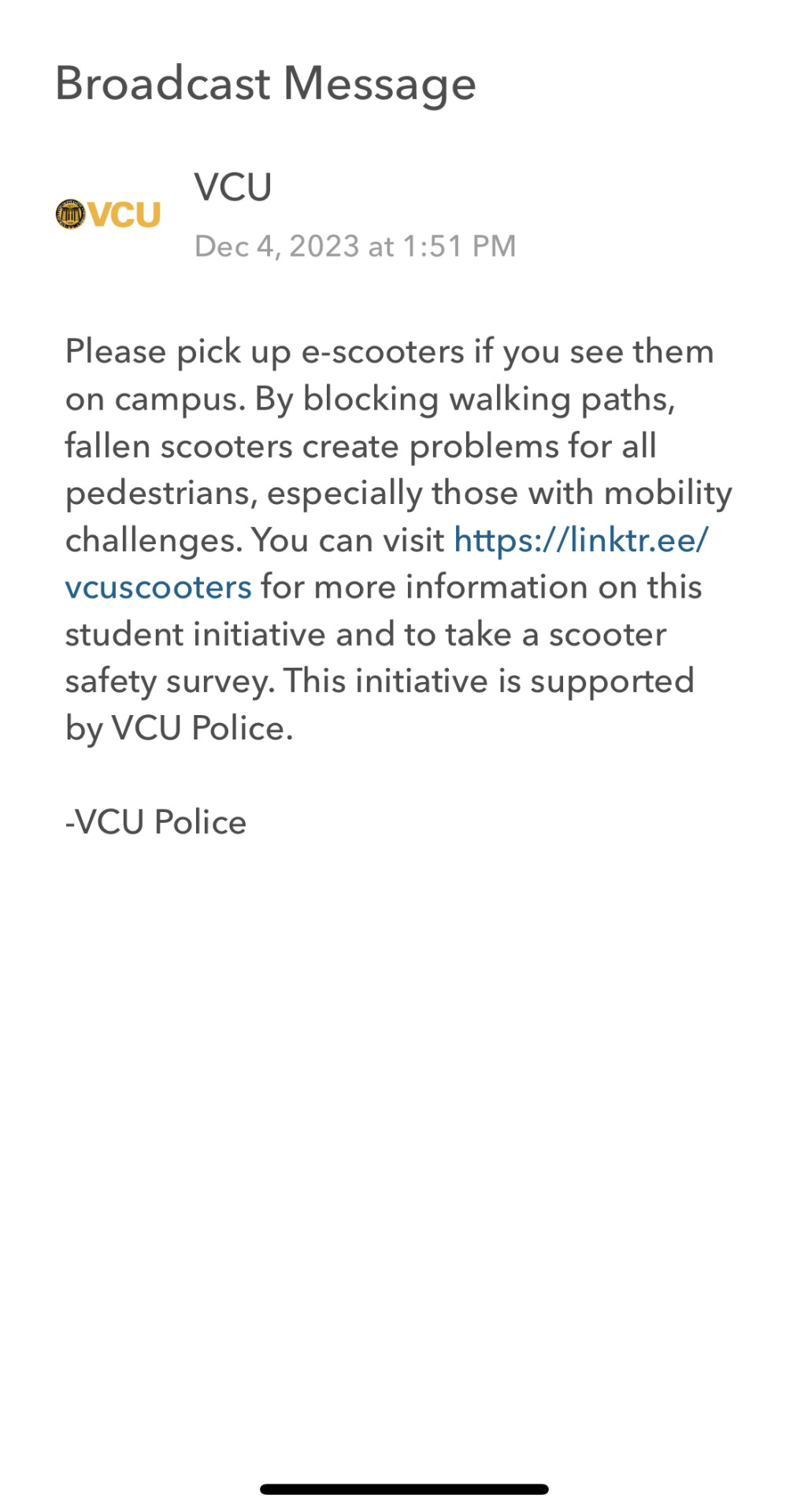
Corey also shared the stats for the Geofence alert and told us that it reached 423 users in the 3 days it was up.
Around when all of these posts and alerts were put up, we also received a large increase in our Link-tree engagement. We got a total of 23 views, 17 unique views, 16 total clicks, 8 unique clicks, and a click through rate of 69.57%.

Towards the end of our project, we also attempted to do an in-person survey at Cabell Library. We set up a table near the library and put out a large candy bowl. We would give people free candy if they completed our survey. The survey consists of questions asking the person if they have seen our posters around campus, if they use a scooter, and if they’ve had scooter related issues in the past. Sadly, we had very limited engagement. We only had 7 people fill out our survey since it was one of the coldest days of the year when we did this. Most people wanted to be in and out as fast as possible.
The very last thing we did during this project to spread our message was distributing even more posters around campus. Since a lot of our older posters were removed, we decided to put up even more. This time, we did a mix of our original scooter posters and also our accessibility issues poster as requested by many people on Reddit. We put them up on poles all over campus, Cabell library, outside apartment complexes, and just anywhere where they had an unlikely chance of getting removed. Like last time, some got removed almost immediately while some still stand even today.
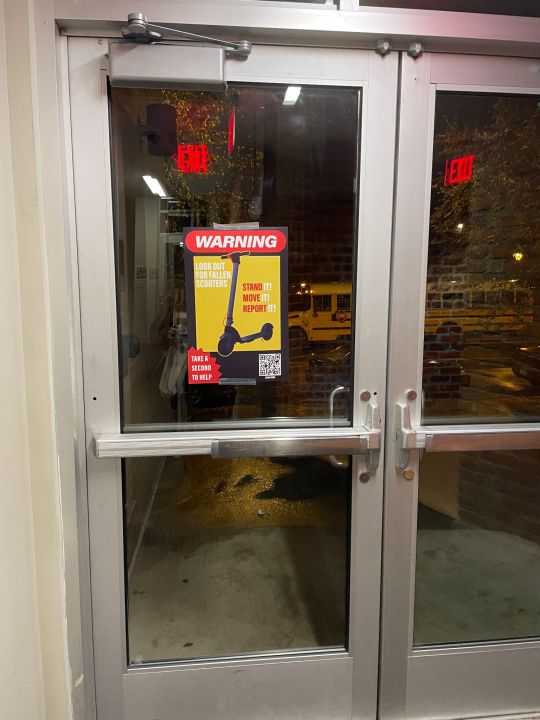

Final Results:
By the end of the semester, we got a total of 145 views, 86 clicks, and a Click-through rate of 59.31% on our Link-tree. We put up over 20 posters around the VCU campus, were posted to VCU’s official Instagram story weekly, and were featured in the Commonwealth Times. We were also posted to VCU Police’ Instagram Stories (122 views), Instagram (508 reach and engagement), Facebook (311 reach and engagement), Twitter (188 reach and engagement), and Threads (0 reach and engagement). We were able to reach 423 users in 3 days with a Geofence alert in 6 locations on campus. We got 33 upvotes and 23 comments on r/vcu and 67 upvotes and 104 comments on r/rva. We were able to get the attention of VCU’s Monroe Park Campus Coordinator, VCU Police, GRTC’s marketing head, and VCU’s head of communication while trying to spread our message. We also got 7 people to fill out our survey during in-person polling.
Towards the end of the Sprint, I got an email from Susan who let us know that she thinks our campaign made an impact on campus. She said that ever since we started our scooter campaign, scooters are no longer as scattered and fallen over like they used to be. She said she no longer sees them in weird places like bushes.

Reflection:
I feel that our project was a success. We were able to distribute our message through many different platforms and methods and were able to reach hundreds of people. Susan who pointed out this scooter problem to us in the first place told us how she believes that our scooter campaign was a success. I feel like this entire project taught me such important skills that I wouldn’t have learned anywhere else. I feel like I learned how to network, learned how to properly advertise, distinguish helpful critique from unhelpful critique, learned how to continue on when things don't work out like they should, and also learned how to properly manage a project that goes on for this long. Even though my major doesn’t have anything to do with product design, I feel that everything I learned in this class can be applied to any career and skills
A couple of things that I wish we did differently would be to start reaching out to people earlier. I feel like we should have tried a more manageable goal from the very beginning rather than trying something so ambitious. We wasted a lot of time trying to contact people and find solutions to a problem that obviously couldn’t be solved in a semester. If I were to redo this project, I would greatly reduce the amount of time we took to plan our project. Because of this, we were very late on reaching out to people to help us distribute our projects. If we began that stage earlier, we could have been able to get our poster printed in the physical version of the Commonwealth Times and have the GRTC distribute our posters.
Overall, I think both the failings and successes of this project will prepare me for future projects in and outside of design.
0 notes
Text
Sprint 4 Overview
Sprint Recap:
For our 4th Sprint, our main goals were to finalize our poster designs, get them printed out, and have them put up around the VCU campus. We also wanted to start submitting our poster design to all the digital screens like the Cabell Library, Student Commons, etc.
The first thing we accomplished during this Sprint was finalizing our poster designs. Lillie and Dalton tweaked the original yellow poster design and added the last bit of information we were missing such as the QR code. They also made another yellow scooter poster we could also put up.
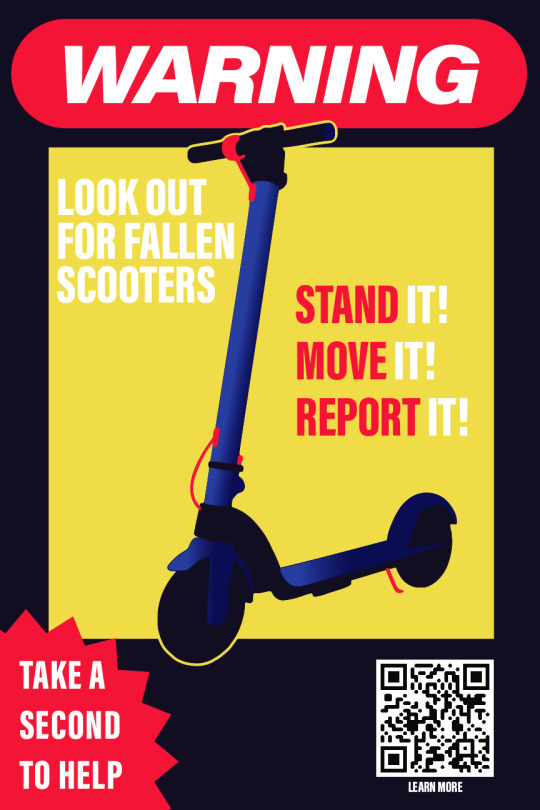
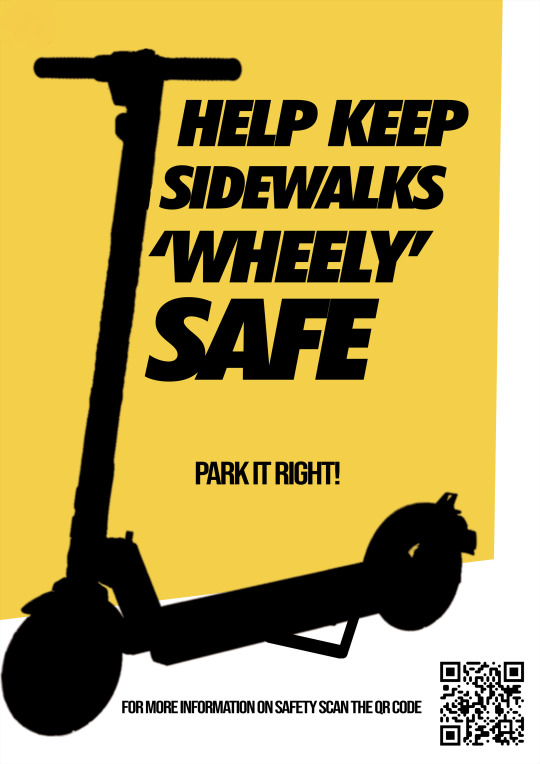
Alo continued working on our Linktree. She researched information about all three of the scooter companies in Richmond and added a section where people can report each company's scooters if they have fallen over. She also looked into how the scooter companies keep track of the scooters and how they try to incentivize people to pick them up.



Something Susan brought up during our last Sprint was that it would be a good idea for us to add information about how to use the kickstands on the scooters somewhere on our poster. We noticed how confusing it can be to locate and push out the kickstands, especially when people are in a hurry. We think that could be one of the reasons why so many people leave them on the sidewalk or prop them up against trees. My group had the idea to make a GIF showing how to use a kickstand and have it be in our “How to Park a Scooter” section in our Linktree.
I decided that I'd work on making the GIF. We wanted to make something very straightforward and easy to understand. I went out and located a fallen Bird scooter. I set up my phone with my water bottle and started recording. I picked up the fallen scooter and used my foot to attempt to kick out the kickstand. I had to retake the video multiple times because I struggled with kicking out the kickstand. It was pretty rusty and stuck in place on the scooter. Finally, I got footage of me kicking out the kickstand in one try.
I then downloaded a GIF-Making app called Gif Maker. I trimmed the video to only have the clip of me kicking the stand down. I then sped up the gif in the app and looped it. It was a straightforward and quick GIF that showed a simple way to kick the stand down. My group agreed but felt that something was missing. I briefly got the free trial for the paid version of the app and added a bright yellow arrow pointing to the kickstand in the GIF. We felt that this conveyed the instruction more simply and made our GIF stand out a little more. Alo added the GIF to Linktree and we finally had the website finished.
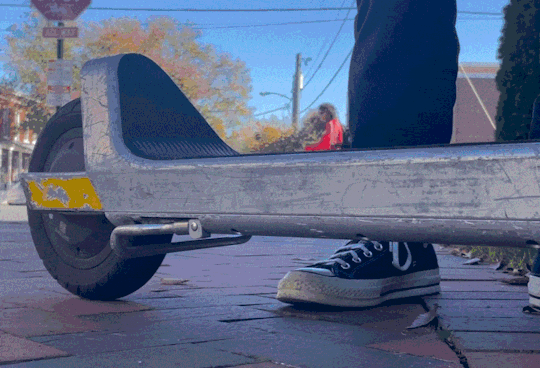
Lillie and Dalton worked on alternative designs for our poster that could go on the various digital screens around campus. All we needed to do now was print our posters, put them around campus, and start submitting our poster designs to digital screen forms online. Last Sprint, I started to research how submitting these forms worked. We decided to submit our poster designs to the Cabell Library digital screen, the Student Commons digital screen, the GRTC bus stops + inside the bus and the Stall Street Journal. We also wanted to look into reserving tables to poll outside the Cabell Library.
I started to work on submitting our posters to these forms because all of the websites stated that it takes about two weeks to process everything and have it displayed. I started by emailing GRTC about possibly having our posters in their buses and at bus stops. Susan sent me the marketing department's email and phone number last Sprint. I both texted and sent out an email.

I got a text almost immediately from Henry that stated that he could meet with us sometime next week to discuss this further.

We talked and decided to meet on Zoom on Wednesday, November 15th, 1:00 PM-1:30 PM.

After this, I started to fill out the form for the Cabell Library. Since Lillie was the one who designed the final poster, we both decided it would be good to put her information into the form. She was very busy that day so I filled out the form using her information. I wrote a brief statement about what our poster is about and why we want to have it displayed. A problem we ran into was that our original poster was not the correct size for the Cabell screen. Even though Lillie was very busy that day, she took time out of her schedule and instantly made a version of our poster that fit on the Cabell screen. I appreciate that! We submitted the form and are still awaiting a response and approval.
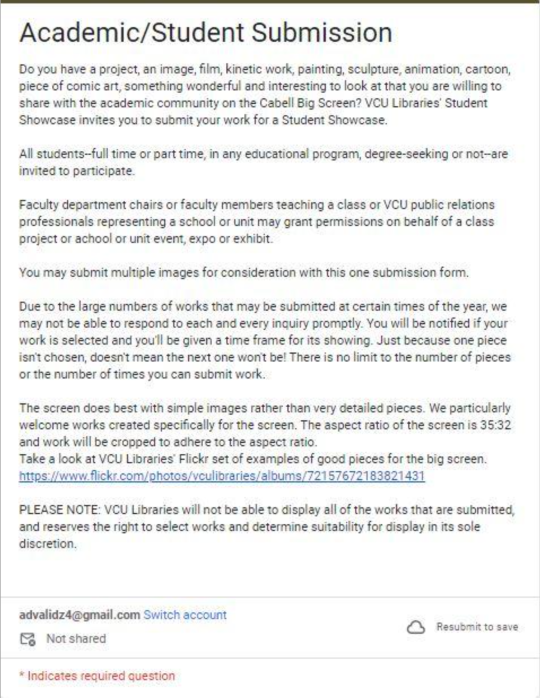
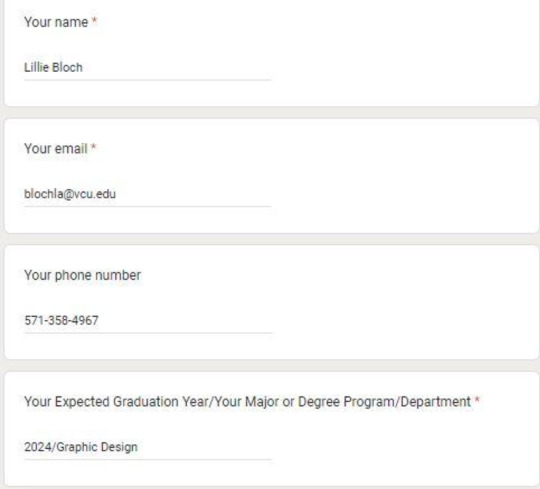
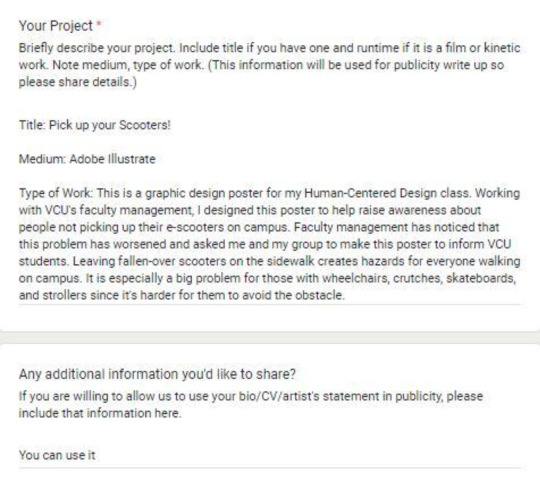


I then started filling out the form for the Student Commons screen. Again, I wrote a paragraph explaining our goal with these posters and how we have connections to the VCU faculty management. We did this to increase our credibility and raise our chances of getting selected. Again, we resized the poster to fit on the Student Commons screen. Lillie redesigned the poster in a longer format and we submitted the form. A couple of days later, we got a response stating that we got the approval and that they were going to start playing our ad on their Student Commons screen.

I also looked into the Stall Street Journal but judging from their form, it seems they only accept topics that have to do with mental and physical health. Our ads would not work with the type of subjects that they cover.
I also looked into the table polling but we decided to set this up during break since it says to fill out the form two weeks before the tabling event. Since it is still early, we will wait a bit before filling it out.
Dalton and Lillie submitted our posters to multiple printing places around Richmond. Almost none of them got back to them or stated they never received their poster for printing. This delayed us a lot because we wanted to have our posters up this Sprint. Lillie finally got a confirmation from Richmond Printing when she resubmitted the files that they would print our files. However, they stated that they would have them by Friday, which is one day after this Sprint ends.
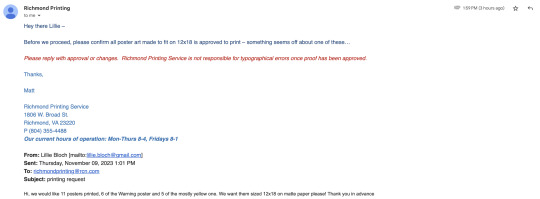
Plans for Sprint 5:
For Sprint 5, our main goal is to have these posters up and around Richmond. We are supposed to get them back from the printing company on Friday and will put them up immediately. We want Sprint 5 to focus on spreading our posters in as many places as possible and getting lots of engagement on our Linktree. We will also try and submit our posters to even more websites and forms. We will contact multiple VCU social media outlets and try to get them to advertise our posters on their story or posts. We will also post our posters on r/rva and r/vcu on Reddit to get feedback and spread more awareness.
I am also meeting with Henry from GRTC marketing on November 15th and hope this will be a step forward in getting our posters up in the buses. We need to schedule a meeting with Susan this Sprint as well to update her on our progress and discuss what else we can do to spread our posters message even further.
Reflections
I feel that we accomplished a lot with this Sprint. Not only did we finish the Linktree but we also submitted our poster design to many websites and digital screens for approval. We even got accepted for the University Student Commons digital screen already. I feel that the pace we are working at is good and we are already spreading our posters to so many places.
Something that I learned during this Sprint was how to create a GIF. I have never made my own GIF before and when I was asked to make one for our Linktree, I was a little nervous. I thought it would be a lot more complicated than it was. All I had to do was edit parts of the video to make sure it was a good length, capture the most crucial parts of the video, and then insert it in the GIF-Maker. I also had to stick some stickers on the GIF but that ended up being very easy as well.
I've also improved at connecting with different people and getting projects approved. I didn't realize before this project how easy it could be to set up meetings with people such as the GRTC. I assumed you had to already have connections and wouldn't be able to get too far. In reality, however, if you simply just send them an email, they are willing to meet with you. I've gotten approval and help from many different people during this project that I didn't realize were so accessible.
Something that I wish we had done differently with this Sprint was submitting our posters for printing earlier. We assumed that the turnaround time would be quick with these printing places so we submitted pretty late to each of them. While we did take into account how long printing would take, we never considered submitting even earlier if things went wrong. Things indeed did go wrong and we ended up not having our posters during this Sprint. For the next Sprint, we need to make sure we are submitting things ahead of time just in case anything goes wrong again. We need time to think of alternatives and backups in that case.
0 notes
Text
Sprint 3 Overview
Sprint Recap:
For our third Sprint, we had a lot of goals planned out. By the end of this Sprint, we wanted to have a couple of sketches and prototype designs ready for our future posters. Furthermore, we wanted to meet with a member of facility management to discuss our current progress with the project, get advice on our designs, and get pointed in the proper direction. We also wanted to look into possibly displaying our posters on the Cabell Library digital screen outside.
The first thing that we accomplished during this Sprint was deciding that we were going to go through with the scooter poster idea instead of the sidewalk one. We wanted our project to benefit and help out Facility Management since they were helping us. While they originally wanted us to do posters for reporting damaged sidewalks, they eventually decided that fallen-over scooters were a bigger problem.
We had a class activity at the beginning of this Sprint where we designed poster prototypes on paper. After getting some tips from classmates, we settled on the fact that our posters had to have bold lettering, a slogan, and a colorful graphic to catch people's attention. My poster had large text that was noticeable from a far distance and Alo's had a catchy slogan. We decided that for our next prototype, we would use a combination of these two posters plus a colorful graphic.
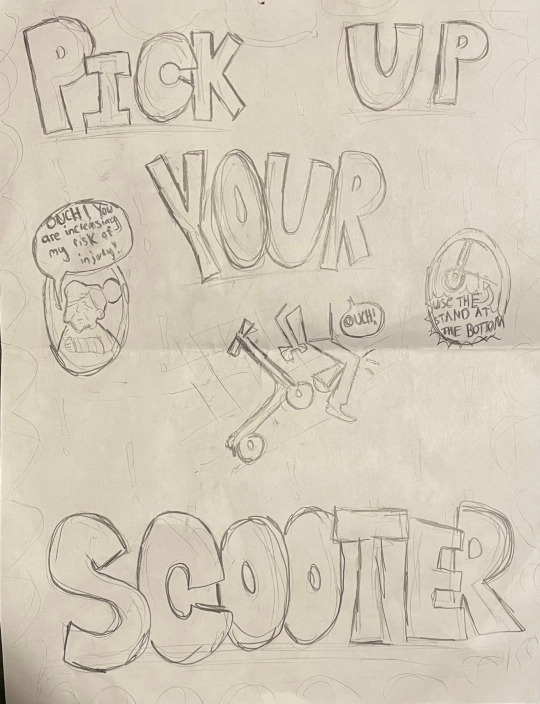
While the rest of the team members were designing their digital poster prototypes, I emailed Susan Sutphin, the Campus Coordinator. She has previously helped steer us in our current direction for this project and offered to help us out even further with future steps. I sent her an email that updated her on our project ideas and asked her what she thought about our work so far. I also asked her if she could somehow distribute these posters for us in ways beyond our power. Sadly, she never responded to this email.

While waiting for a response from Susan, I started to design some graphics that could go on the poster. My first idea was to draw a man lying next to a knocked-over scooter with a look of pain on his face. A large crowd gathers to watch him in pain while a text saying "Don't be a Loser, Pick up your Scooter" is displayed. This slogan was created by Alo for her first prototype poster. I felt like this design might not emotionally resonate with people like I wanted it to .

I made a second graphic of a person in a wheelchair looking beyond a sidewalk covered in fallen-over scooters.


My last design was of an old lady tripping over a fallen scooter. I thought portraying someone elderly instead of someone young might make people more inclined to pick up their scooters.

After waiting a couple of days for Susan to respond, I emailed her asking if our whole team could instead meet in person to discuss our posters. She swiftly responded and told me that we could. We decided we would meet at the library. Sylvia J Britt, the director of contract admin, was supposed to meet with us too but was busy.






I prepared a list of questions to ask Susan before we met up. We wanted to make sure that the direction we were heading with our posters was the most effective it could be. The list consisted of questions I asked her in the initial email and some new ones.
The next day, we met up with Susan in the library. We discussed whether or not posters were the best method to convince people to pick up their scooters. Susan told us that posters were a great idea and that she would help us distribute them. She told us that she had contacted GRTC to try and have our posters hung on their buses. She said that people who ride the buses also use scooters to get to the bus stops, making it a great place to advertise our posters. She also contacted the people in charge of the Cabell Library outdoor screen, Seigel Center screen, and the Bathroom Stall Newspaper to see if we could get our posters there.
She also suggested we hang posters in dorms, common areas, along Broad Street, and at local restaurants. We would need permission for most of these so Lillie asked if we could also put up some posters around the city without asking permission. Susan said we could since the worst that could happen was for someone to remove them.
After this, we showed Susan our poster prototypes to see what she thought. She really liked Lillie's poster and thought the idea of putting a QR code on the poster was a good idea. I showed her mine as well and she liked the idea of having a little segment telling people to use their kickstands. She suggested I switch the graphic of the grandma falling over to a VCU student falling over as she felt VCU students would sympathize with that more. She also suggested we include a kickstand alert on our final poster
Besides putting up just posters, Susan thought it would be really effective to design stickers that could go on scooters warning people to pick them up. Since they are directly on the scooters, it would be impossible for the person riding it to ignore it. If we were to go with this method however, we would need permission from the scooter companies to display stickers on their products. Susan said she would email the scooter companies about this since she has close connections with them.
One of my final questions to Susan was if there was anyway we could detect if scooters are being picked up as a result of our posters. She said that if people use our QR code, we could track it through there. We brought up the idea of possibly setting up a stand outside the library and polling people about whether or not they have interacted with our posters. Susan suggested we offer them candy as an incentive. She also suggested we contact VCU and have them send every student a survey about our posters. I also brought up how we could ask on r/RVA and r/VCU on reddit since those two communities care about things like this.
After we wrapped everything up, she suggested that we should have our poster ready and put up by mid-November. This is so people have enough time to see them around the city before we poll them.

After this meeting, Dalton showed us his poster prototypes. We thought they were amazing and wanted to polish and use these designs. We especially liked his yellow scooter poster because it had a bold color palette, an easily identifiable scooter graphic, and large words. Dalton and Lillie continued to work on perfecting this poster by working on consistent and appealing color palette's, playing with graphics, and trying to find the perfect composition. Alo started to work on our link-tree and added information about how to report fallen scooters. Dalton also looked into a lot of local printing companies such as Uptown Color and the Pollack buildings printer to see where we could print our posters for the cheapest price with the best quality.
After the meeting, Susan sent me a lot of links that consisted of where we could submit our poster designs to have them put up on the Seigel Center screen, Student Commons, Cabell Library Screen, and the Bathroom Newspaper.


I've looked into these programs websites and for all of them, we have to fill out and submit forms featuring our poster. We have to submit our posters at least two weeks in advance to get a chance to have them displayed in these locations. They can also decline to have our poster featured so we have to make sure we submit to all of these forms to at least get our posters displayed on some of theses screens/places.
Plans for Sprint 4:
For Sprint 4, the first thing that we have to do is get our posters printed and displayed. Before we submit our posters to the online forms to have them displayed on screens and common areas, we have to do a short test run in heavily populated spots of the VCU campus to see if they get noticed or change any scooter behavior. Based off of our results for this test, we will tweak our poster designs to try and make them as appealing and noticeable as possible. Initially we will only print around 10 of these posters and put them up in heavily populated areas.
Along with this, we also want to have our final poster designs put up during this Sprint. We need to have these posters up for at least a month before we start polling so that people have a chance to interact with them. We also want to have our final poster design submitted to all of the forms for the Cabell Library Screen, The Students Commons, etc. We want to make sure we have them submitted early since they take around two weeks to be put up on the digital screens.
Before we do all of this however, we need to pick one printing company so that we can get these posters out as fast as possible.
Reflections:
Since this Sprint was a little longer than our previous ones, I feel like we have gotten a lot of stuff finished. We were able to complete many prototypes for our posters and have them approved by Susan. We were also able to get so many connections through her that would help us display these posters in ways we couldn't access on our own. We even started looking into printing companies to have our posters printed.
Something that I was able to improve on during this Sprint was my ability to ask questions in-person. I have already had meetings with Faculty Management at VCU so I have already been asking questions in-person for our project. However, with my previous meetings, the questions that I was asking were spontaneous and un-planned. I had these questions written down but wouldn't refer to them while I was having the meeting. It was only after the meeting was over when I'd realize that I had forgotten to ask certain questions I had written down. This would lead to me having to email Facility Management again. With this meeting, I felt like I was more prepared. I made sure to bring in the questions I had for Susan and prepare all of them ahead of time. I was able to get every question I had answered by her. At the same time, I didn't strictly stick to just these questions. I also let the conversation be a lot more flowing so that we could bounce ideas off of each other and come up with new ones through this.
I also feel like my notetaking has improved. I used to write down notes after my meeting with Facility Management was over. This was so I could fully pay attention to what the speaker was saying. This however, led to me forgetting certain details of our conversations. This time, I would jot down keywords that Susan was saying so that I wouldn't forget them after the meeting. I would then write more in-depth notes based on these keywords after the meeting was over. The fact that I only wrote down keywords also made me make sure I wasn't stifling the conversation by writing down every detail and ignoring the speaker.
Something I feel that should be improved in the next Sprint is my workload. I feel like I did a lot of work at the beginning of the Sprint but towards the end, it felt like I wasn't doing too much since we were mostly just focusing on designing and perfecting the posters. The entire group cannot work on designing the posters so I felt like I didn't have too much to do. With next Sprint however, we are focusing on distribution and printing so those are things that all of us can participate in.
0 notes
Text
Sprint 2 Overview
Sprint Recap:
For our second Sprint, we decided to shift our goals for this project. The events I will talk about in further detail in this blog showed us that our current goal seemed to be unachievable within the time period of this project. We decided to shift our goal from trying to get the sidewalks at VCU repaired to trying to raise awareness for sidewalk safety at VCU.
As a group, one of the first things we did during this sprint was take a trip to the Cathedral of the Sacred Heart. This location in particular had really bad sidewalks and was the main area we wanted to focus on repairing. We’ve emailed the church multiple times but they’ve never responded to us. We decided it would be best to go in person and speak with the Bishop about our possible sidewalk repairs. Since the bishop is directly in charge of the sidewalks of that area, we wouldn't be able to make any progress if we didn’t get an okay from him. All members of the group prepared questions to ask the Bishop. These included questions about if we could repair the sidewalks, how often they got repaired, etc.
When we all arrived at the cathedral with our questions, we tried to enter the building but realized it was closed. We were very confused because when you looked up the cathedral hours on Google, it showed that they were open until 4:30 P.M. that day. It was about 1:30 P.M. so there should have been no problems. We then noticed the sign on the door of the building. It stated that the cathedral was closed all week because of repairs being made inside. The only time it was open was during church service. We had no other choice but to just go home.
I don’t have any photo proof of the cathedral being closed that day but when you go on their website, it shows that they are constantly closed because they are trying to place a new pipe organ.


Around the same time that the cathedral trip was happening, I got an email response back from VCU's Facility Management to find out who was in charge of VCU's sidewalk repairs. I originally sent this email out during our first Sprint but didn't receive an email back until now. Paul Thrift, the Superintendent of Grounds at VCU told me that some sidewalks belonged to the city and some belonged to Richmond. He didn't clarify which ones but said I could bring specific sidewalk issues up to his department.

I followed up his email by asking him three questions. I asked him who was in charge of sidewalk management at Cathedral Pl, how often brick sidewalks at Monroe Campus were being repaired, and if the red brick around campus had historical protections in place. While we have already received the answer to who is in charge of sidewalk management at Cathedral Pl, I wanted to double-check.

I received an answer from Paul that the sidewalks adjacent to the Sacred Heart Cathedral Church were the Bishop's responsibility, as we already knew. He said he could find me a point of contact with the church and refer me to them. He also clarified how the sidewalks on the opposite side of that same street were VCU's property besides the sidewalks in front of private homes. The sidewalk south of Sacred Heart belongs to the City of Richmond. He clarified that VCU's brick sidewalks are repaired when issues are discovered, when resources allow, and when someone brings it to their attention. He also informed me that the VCU brick sidewalks do not have any historical significance that he is aware of such as being on the National Register of Historic Places.

My final response to Paul was asking him to refer me to someone who could help me with sidewalk information from the Sacred Heart Cathedral. So far, he has not responded

I also sent out an email to the City of Richmond asking similar questions to what I asked Paul such as how often they repair sidewalks, if they have any plans to repair sidewalks surrounding Cathedral Pl, and more. I have not received an answer from them yet.

After all of this, we met up in class to discuss our future plans for our project. We decided that we were currently getting nowhere with our goal. No one was getting back to us in a timely manner about repairing sidewalks and it seemed we wouldn’t even be able to do that in the first place because it would take longer than this semester. We brainstormed a little and talked with the Professor to try and see if we could do something else sidewalk safety-related that didn't involve us repairing the sidewalks. We decided that alongside trying to get in contact with the church, we would also be asking Paul Thrift if there were any sidewalk-related problems we could help him with. Our thought was that if we offered to help the Facility Management team with sidewalk-related problems they were already having trouble with for free, they’d be more willing to help us out with this project.
I sent out an email to Paul Thrift asking if we could have a meeting with him to discuss further questions about the sidewalks and our project. Before this, he was responding very consistently but he never ended up responding to my email. I tried to call him on his cell and work phone twice as well but got no response.

Calling and emailing people seemed to be getting us nowhere with this project. I decided it would be best if I met up with Paul Thrift in person. I went to the Faculties and Financial Services building and went to the office for Faculty Management on the second floor. I spoke with the person at the front desk about meeting up with Paul Thrift today. She directed me to speak with Roxanne Razo, the Director of Staff Operations at VCU.
Roxanne informed me that Paul’s office was at the MCV Campus and that he was often not at his office. She said that my best bet getting a meeting with him would be to call or email him for an appointment. Since I’ve already tried to call and email him with no luck, I asked if there was anyone at the building I could currently speak with about the VCU sidewalks. Roxanne told me I should meet with Sylvia J. Britt, the Assistant Director of Contact Admin.
Roxanne brought me to her office. I talked with Sylvia about our class and what we are doing for our project. I told her about our initial plan for repairing the sidewalks and I informed her about our new plan as well. Just as we all thought, our original plan would be very hard to accomplish. She said we could not make changes to VCU’s sidewalks because they follow strict design standards and that the bricks at VCU DO have historical relevance. She also said it is inevitable that the bricks would be in this condition thanks to the roots from the trees on the sidewalks. She told me that there are people scheduled to repair most of the reported and damaged VCU sidewalks but the process was very slow and took a while to get to them all.
While I was talking with Sylvia, Susan Sutphin, VCU’s Campus Coordinator walked into the room to say hi to her. Sylvia asked her to help us out with this sidewalk project since she had direct control over the VCU sidewalks. She ended up specifying the same things as Sylvia. She did acknowledge that the sidewalks have a lot of problems and that she wasn’t able to take her grandmother around The Fan because of the sidewalk conditions. She said there was no way that we could repair the sidewalks quick enough for our project.
I explained to Susan and Sylvia if there were any other sidewalk-related problems we could help them with. I specifically mentioned ideas such as possibly making caution posters for potholes. Susan said that signs like this were not allowed to be put up on campus unless we got approval from the City of Richmond. I informed Sylvia and Susan about our group's graphic design knowledge and asked if there was any way we could use that to help them with sidewalk issues.
Sylvia told me that the issue they were having the most trouble with right now was getting students to report damaged Sidewalks to VCU. She and Sylvia said it would be great if we could make posters telling students to report damaged sidewalks. She said to put her email ([email protected]) on the poster and for students to make the email subject line “Safety” when they are reporting. The only suggestion besides that was that we had to make sure to take down all the posters by the end of the semester.


It seemed we had finally had a plan for our project. We finished this sprint off by discussing our goals and ideas for these posters and looking into what constraints we might possibly have.


At the very end of our Sprint, I got an email from Susan about a possible change to our plans. She told me that she thought a lot more about our project since the last time she spoke to us and realized that a bigger sidewalk-related problem that they were facing was students not picking up e-scooters. She talked about how they litter almost all of the VCU sidewalks and that it’s very hard for people with disabilities and the elderly to pick them up and get through. She thinks that it would get to students more if we were to make some type of poster about picking up the scooters as opposed to VCU making anything. She then ended her email telling us she’d help us out any way she could.

The very last thing we did for this Sprint was consider whether or not it was a good idea to go down this route as opposed to the previous idea. Lillie’s group last year did almost the same exact project so we weren’t sure if this would be allowed.
Plans for Sprint 3
For Sprint 3, the first thing that we need to do is decide which path we would like to go down for our final project. Would we rather make posters about picking up scooters or would we rather make ones about reporting damaged sidewalks. At the moment, we are leaning more toward the scooter idea because that’s what the VCU Faculty Management prefers.
Next, we want to finalize our poster prototypes and settle on a design that is eye-catching and will get people to actually do what we are asking them to do. Right now, we plan on making both paper posters and a digital poster that the library can advertise. Lillie has connections with people at the library and is going to try and get our poster on the big screen of the library. We ran our poster prototype designs through a test run in class today and determined we needed to make a poster with large bold lettering, a slogan, and a colorful graphic to catch people's attention. We also want to incorporate a QR code into our poster so that people can scan it and get information about why not picking up the e-scooters negatively affects everyone if that's the idea we go with.
We also plan to email the Facility Management Department and run our ideas through them since this is meant to be something that benefits them as well. They can give us feedback and critique on what they think we should do.
Our main goal for this Sprint will be to try and finalize our poster design.
Reflections
I am very proud of how much we accomplished during this sprint. With the previous one, we weren’t able to make too much progress because we relied entirely on emailing people. During this sprint, I learned that sometimes you just need to get something done even if you have to get out of your comfort zone. I am very socially awkward and try my best to avoid communicating with people I do not know outside of text. After not getting any email response back from Paul Thrift or the bishop, I realized that we were going to get nowhere if we continued like this. I went to the Facility Management Office without scheduling an appointment and was able to speak with people I didn’t even know had so much authority over the sidewalks. I was able to get all the information we needed in a day instead of waiting weeks for slow answers.
I’m also very happy with my team, for coming up with so many ideas for our posters. I feel like we all got a lot better at communicating with each other. Compared to the first sprint, we talk over text a lot more and discuss our plans thoroughly in class. Our goals and ideas feel a lot more connected and less disjointed now because of this. In the previous sprint, we kind of all did our own thing and didn’t really think of the greater picture for our project. Now, we have a very good balance of individual research and team work.
One thing I hope to do differently during the next sprint is to not take up all of the research positions. Since neither of the cathedral reviews worked out, I feel like I didn’t leave any research or work to do for my other team members. I should have split some of my interviews with the Facility Management so that we would all be able to have direct contact with them. In the future, I want to make sure that everyone is able to participate equally. For our next sprint, we will all have an equal part in designing our poster.
0 notes
Text
Sprint 1 Overview
Introduction:
Richmond is a city known for its walkability. Compared to other United States cities, Richmond has an impressive sidewalk network that makes getting from one neighborhood to another relatively easy. Sidewalks won't end in the middle of the road and everything is a short distance away from each other. It seems almost perfect until you realize the condition of these sidewalks. Missing chunks and misaligned pieces of brick litter the sidewalks surrounding Richmond. Areas near the VCU campus especially have very rough sidewalk conditions. The current conditions could pose a real danger to pedestrians who could easily trip and get hurt if they weren't looking too closely. Our goal as the Sidewalk Surgeons is to figure out a solution to make the RVA sidewalks less hazardous for pedestrians by researching, documenting, and interviewing the people of Richmond.
Sprint Recap:
For our first Sprint, our goal was to research basic information about the Richmond sidewalks such as who owns them, who repairs them, their legal protections, how long they've been in this condition, and more. We then focused on interviewing, polling, and observing the residents of Richmond/VCU to see if they've had any troubles caused by the sidewalk conditions and if sidewalk repair was a problem they cared about. Observations showed that a lot of pedestrians were struggling to walk on the Cathedral Place sidewalks. We focused the most on the Cathedral Place sidewalks because of the intense damage they displayed. We determined that the Bishop of the Cathedral of the Sacred Heart is in charge of repairs to that specific sidewalk. We also looked into ways to repair the sidewalks and the legality and likelihood behind each method. We determined that repairing the sidewalks might pose problems because they are historically protected and we might not be allowed to alter them.
My goals during this first Sprint were to research who was in charge of the sidewalks around different parts of Richmond, learn how to request repair for the sidewalks, and see if and how VCU students were affected by the damaged sidewalks. The first thing I did was research who was in charge of the sidewalks in the Richmond area. This brought me to the City of Richmond's website, clarifying that two companies repair Richmond sidewalks. Roadway Maintenance takes care of project areas smaller than half a block while Capital Projects Management manages larger projects. This page also included ways to inform the City of Richmond about damaged sidewalks such as their Customer Care number and a request form known as RVA311.

My next step was to email VCU's Facility Management to find out who was in charge of VCU's sidewalk repairs. I didn't receive an email back during the first Sprint but received a response two days ago. I will be including this in the second Sprint since they emailed me back after the first Sprint.

I also emailed the City of Richmond asking questions such as how often they repair sidewalks, if they have any plans to repair sidewalks surrounding Cathedral Place, and more. I have not received an answer from them yet.

To see if VCU students were being bothered by the current condition of the sidewalks, I decided to put up a poll on the VCU subreddit. I asked the students on the subreddit if they had been negatively affected by VCU's damaged sidewalks. I made this poll a simple Yes or No response and told people to comment their thoughts. The results I got back included 27 people voting Yes and seven voting No. Only one person commented specifics about their negative experiences with VCU’s sidewalks. They said that in their experience, the city-maintained sidewalks were worse than those adjacent to VCU property. They said they could usually count on VCU sidewalks being more accessibility-friendly and that at least VCU uses an angle grinder to smooth out their uneven sidewalk sections. At this point in the research, we hadn't considered that a lot of the sidewalks we considered unsafe could be owned by the City of Richmond rather than VCU. Perhaps, this wasn’t a problem with VCU’s legislation like we originally thought.

After this initial poll, a moderator for the VCU subreddit suggested that I make the poll more specific and add whether people are getting injured and the severity of said injuries. The new options I added include I have had a sidewalk incident that had no injuries, I had a sidewalk incident that resulted in minor injuries, I have not had any issues with the sidewalks, I have had a sidewalk incident that resulted in damage to property (cell phone, bike, etc.), and an option to put extra details in the comment section of the post.

The moderator pinned my poll in the subreddit to ensure people were able to see it. I deleted my old poll because the new one had more specific information. The only photographic evidence of it I have are the two images above.
When the poll was over, 111 people voted. 44 said that they had a sidewalk incident that led to no injury, 18 said they had a sidewalk incident that resulted in minor injury, 40 said they had no issues with the sidewalks, six said that they had an incident with the sidewalks that led to damage to their property, and three people put specifics in the comment section.

The first commenter specified that they had never had a sidewalk emergency but didn't feel safe or comfortable walking on the sidewalks

The second commenter talked about how they were skateboarding on the sidewalk, hit a crack, and flew off their skateboard. They scraped their shoulders and stopped cruising around campus with their skateboard. They said it’s really hard to skate on VCU’s sidewalks because of these conditions.

The last comment specified that if people weren't on their phones, they would have no problems with the sidewalks.
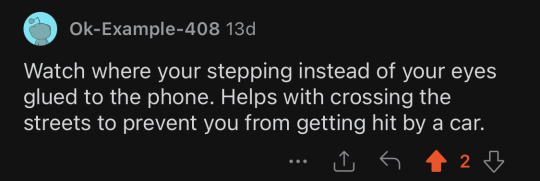
These polls show that there seems to be a large amount of people who are bothered and get hurt because of the sidewalk conditions. There is also a very large amount of people who do not seem to care but they are still outnumbered by those who do. A large enough demand exists from VCU students to get these sidewalks repaired.
Plans for Sprint 2
For Sprint 2, our initial plan was to try and meet up with the Bishop of the Sacred Heart since he was the one in charge of the specific Cathedral Place sidewalk we've been observing. We planned on meeting with him on the 28th to see if he was okay with us repairing the sidewalks but sadly the church was closed for construction. The church is only open during mass. Our new plan is to have two people from the group try and attend mass. After it is over, they can try and interview the Bishop with a set of questions we have prepared.
Our other plan is to look for an alternative path just in case the Cathedral Place repairs don't work out. It's been very hard to get in contact with anyone from the church so we need to make sure we can fall back on another project if this one fails or takes too long.
I've been in contact with Paul Thrift, the Superintendent of Grounds at VCU. He told me he would try and get me in contact with someone from the Cathedral. If sidewalk repairs prove to be too difficult for us to try and accomplish during this project, we're thinking of instead focusing on less direct actions to try and keep pedestrians safe from the sidewalks. We asked Paul if there are any problems that the VCU Facility Management or anybody that is in charge of sidewalks at VCU needs help with. We could instead design posters to warn people of damaged sidewalks or raise awareness in any way that could benefit the VCU Faculty Management's sidewalk problems. My next goal with this plan is to set up a meeting with Paul to try and explain my plan.
Reflections
This first Sprint was the first time I've done a real-world project like this. I feel like we were a little too ambitious with our goals because of this. Having the Cathedral Place sidewalks repaired by the end of this semester is a process that takes way longer than any of us anticipated. It takes weeks for people to get back to us and each step of this process is way too slow for us to be finished by the end of the semester. I learned that we need a backup plan when it comes to projects like this. If we put all of our eggs into one basket, we might not be able to have anything accomplished by the end of the semester at this pace. This is why for the rest of the project, we will be focusing on a smaller scale goal instead.
I also learned that while it is good for everybody to have their own goals during a project, we still need to have collaboration so that our research all connects together. I feel that we have all gathered a great amount of research and that everybody in the group put in a large amount of work. While our individual research was good, I feel like we didn't do too much collaborative research so that we could all be on the same page and try and get to the same goal. For our next sprints, we will be doing more group research such as interviewing the Bishop or discussing our plans with Paul Thrift.
1 note
·
View note